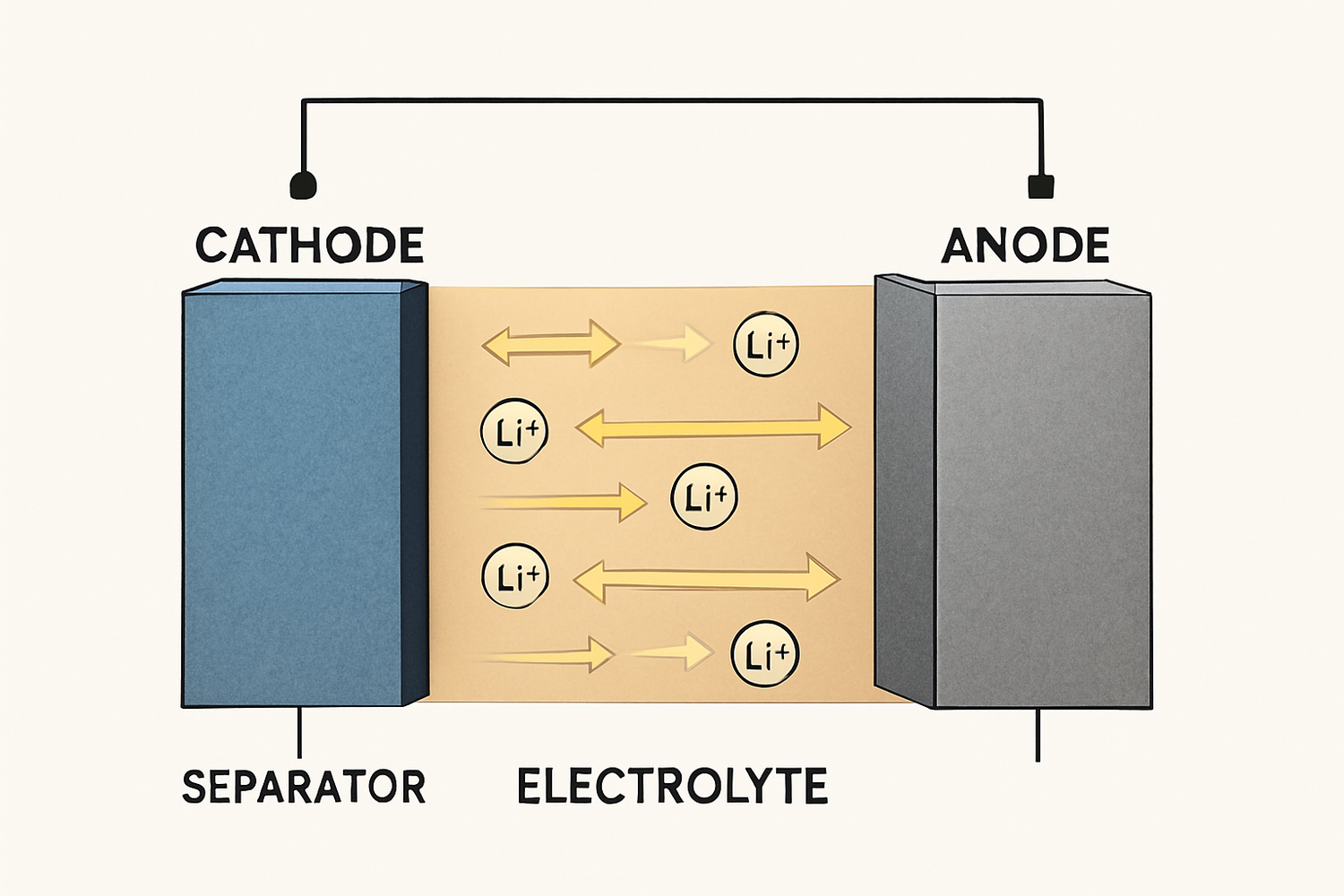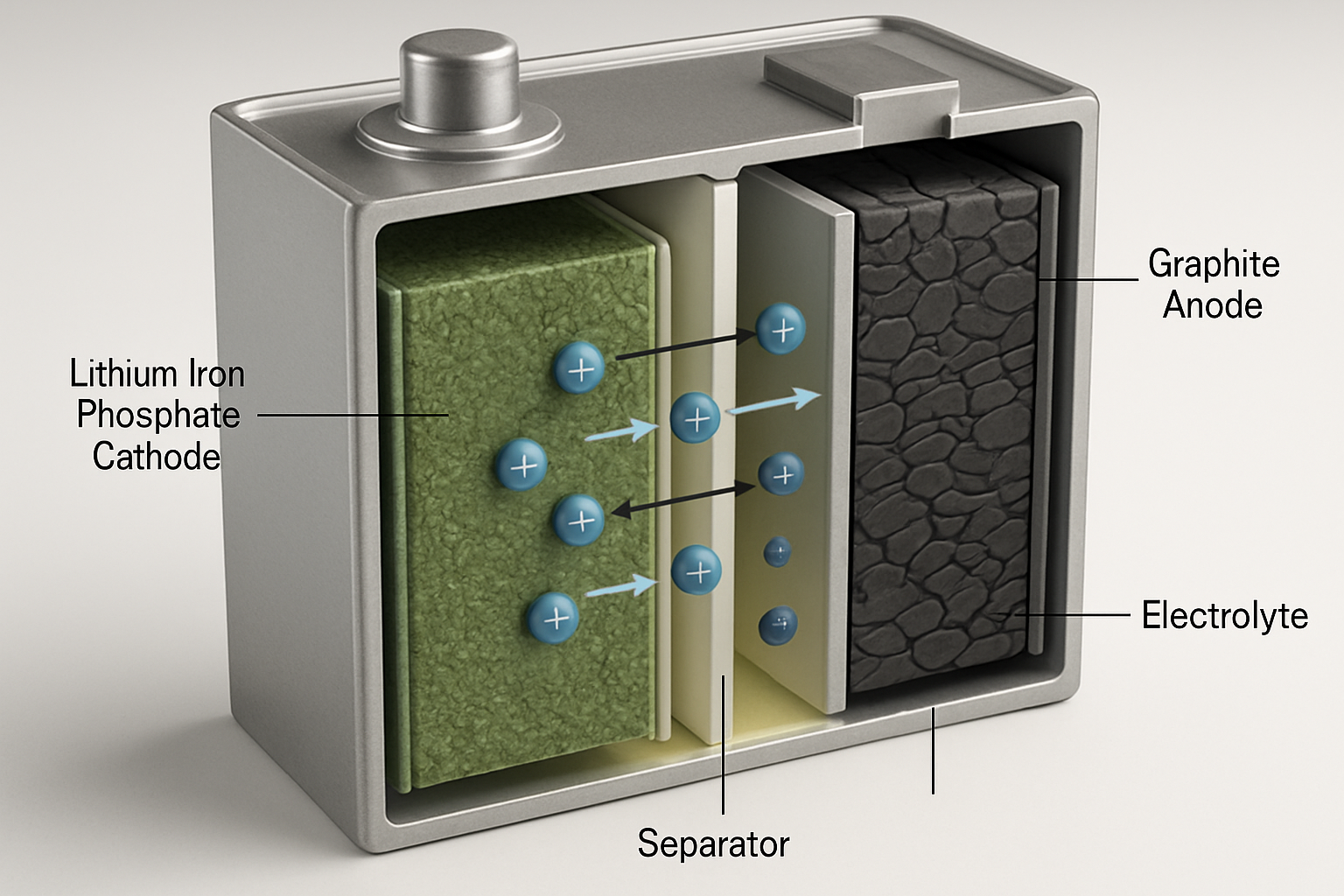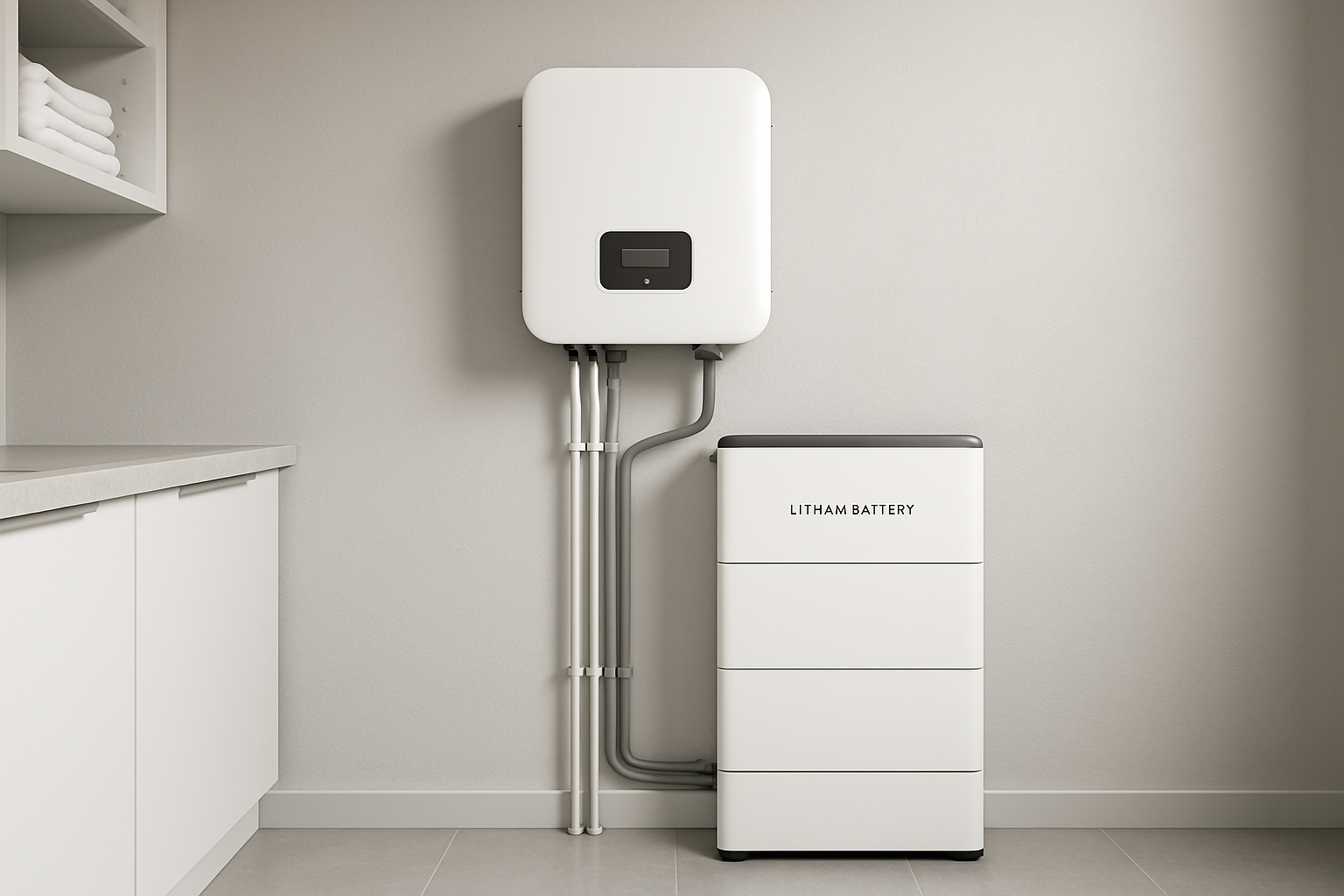Lithium-ion batteries are central to modern life, powering everything from smartphones to entire homes. As solar and off-grid energy solutions become more common, understanding what goes on inside these batteries is more important than ever. The term "lithium-ion" covers a wide family of different battery types, each with unique characteristics defined by its internal chemistry. This chemistry dictates a battery's performance, lifespan, safety, and cost.
Making an informed decision for a home energy storage system requires looking beyond the brand and understanding the core technology. This overview will explain the fundamental components of lithium-ion batteries and break down the most common chemistries, helping you select the right technology for achieving energy independence.
The Anatomy of a Lithium-Ion Battery
Despite the variations, all lithium-ion batteries operate on the same principle and share four essential components. The interaction between these parts allows the battery to store and release energy.
The Four Key Components
- Cathode: The cathode is the positive electrode and the source of lithium ions. The material used in the cathode is the primary factor that determines the battery's specific characteristics, such as capacity, voltage, and safety. This is why batteries are often named after their cathode material (e.g., Lithium Iron Phosphate).
- Anode: The anode is the negative electrode. During charging, it stores the lithium ions that move from the cathode. Graphite is the most common material for anodes, valued for its ability to hold a large number of ions.
- Electrolyte: The electrolyte is a chemical medium that allows lithium ions to flow between the cathode and anode. It contains lithium salts and acts as a conductor for ions but not for electrons.
- Separator: This is a micro-porous membrane that physically separates the cathode and anode, preventing a short circuit. While it blocks electrons, it allows ions to pass through via the electrolyte.
How It Works: The Flow of Ions
The process of storing and using energy is a simple, elegant cycle. When you charge a battery, an external power source applies a voltage. This drives lithium ions from the cathode, through the electrolyte and separator, to the anode, where they are stored. When you discharge the battery to power your home, the process reverses. The lithium ions flow back to the cathode, releasing stored energy and creating an electrical current. This fundamental mechanism is what makes rechargeable lithium-ion technology possible.
A Guide to Common Lithium-Ion Cathode Chemistries
The cathode material is where the magic happens. Different combinations of minerals in the cathode give rise to significantly different battery characteristics. For applications like solar energy storage, the choice of chemistry has major implications for safety and long-term value.
Lithium Iron Phosphate (LFP or LiFePO4): The Safety-First Choice
Lithium Iron Phosphate batteries use a cathode made from LiFePO4. This chemistry is recognized for its exceptional safety and stability. The phosphate-based structure has strong molecular bonds that are highly resistant to overheating, making LFP batteries much less prone to thermal runaway than other lithium-ion types. This inherent safety makes them an ideal fit for residential energy storage systems, where safety is a top priority.
Beyond safety, LFP batteries deliver a very long cycle life, often capable of thousands of charge-discharge cycles with minimal degradation. This durability ensures a long service life for a home or off-grid power system. While their energy density is slightly lower than some alternatives, their focus on safety and longevity provides significant long-term value. For more details, see our article, What Is a Lithium Iron Phosphate Battery (LiFePO4)?, or get help selecting the right one with our guide on How to Select the Best 12V LiFePO4 Battery for Your Needs.
Nickel Manganese Cobalt (NMC): The Energy Density Leader
NMC batteries feature a cathode composed of a combination of lithium, nickel, manganese, and cobalt. This chemistry is engineered for high energy density, meaning it can store more energy in a smaller, lighter package. This characteristic has made NMC the dominant chemistry for electric vehicles (EVs) and portable electronics, where space and weight are critical constraints.
However, this high energy density comes with trade-offs. NMC batteries have a lower thermal stability compared to LFP, increasing the risk of thermal runaway if damaged or mismanaged. They also typically have a shorter cycle life. According to the International Energy Agency (IEA), the push for higher energy density in EVs has led to a focus on nickel-rich chemistries, but this also creates concerns about mineral supply chain stability. For a direct comparison, explore our analysis: LFP vs. NMC Safety: A Deep Dive Into Battery Chemistries.
Other Notable Chemistries (LCO, NCA, LMO)
While LFP and NMC are the most relevant for stationary storage, other chemistries exist:
- Lithium Cobalt Oxide (LCO): One of the earliest chemistries, LCO offers high specific energy but is limited by a shorter lifespan and lower thermal safety. It is primarily used in smaller consumer electronics like phones and laptops.
- Lithium Nickel Cobalt Aluminum Oxide (NCA): Similar to NMC, NCA offers high energy density and is used by some EV manufacturers. It shares similar performance trade-offs regarding safety and cost.
- Lithium Manganese Oxide (LMO): LMO batteries are known for good thermal stability but have a more limited cycle life, which has restricted their widespread use in long-term storage applications.
Performance Metrics: Comparing Chemistries Side-by-Side
To truly understand the differences between lithium ion battery types, it helps to compare them across key performance metrics. These factors directly influence how a battery will perform in a real-world application.
Energy Density vs. Power Density
These two terms are often confused but measure different things.
- Energy Density is the amount of energy a battery can store relative to its mass (measured in Wh/kg) or volume (Wh/L). A higher energy density means a longer runtime from a lighter battery. Lithium-ion batteries offer a significant advantage here, with energy densities ranging from 90–260 Wh/kg compared to 35-40 Wh/kg for traditional lead-acid batteries.
- Power Density is the ability of a battery to deliver power (energy transfer rate) relative to its mass (W/kg). A high power density is needed for applications requiring large bursts of energy, like starting an engine.
Cycle Life and Longevity
A battery's cycle life is the number of full charge and discharge cycles it can endure before its capacity degrades to a certain point (typically 80% of its original capacity). This is a critical factor for the return on investment in a solar storage system. LFP batteries lead in this area, consistently delivering 3,000 to 5,000 cycles or more, while NMC batteries typically offer 1,000 to 2,000 cycles. A longer cycle life translates directly to a longer-lasting, more reliable energy system. To learn more about this, read about the 5 Key Factors When Choosing a Deep Cycle Lithium Battery.
Safety and Thermal Stability
Thermal runaway is a critical safety concern where a battery enters an uncontrollable, self-heating state that can lead to fire. The chemical stability of the cathode material is the primary defense against this. The strong oxygen bond in the LiFePO4 crystal structure makes LFP batteries exceptionally resistant to thermal runaway, even under conditions of overcharging or physical damage. NMC cathodes are less stable and can release oxygen at lower temperatures, which can fuel a thermal event. This makes LFP the clear choice for applications where the battery is installed inside a home or garage.
Chemistry Comparison Table
| Feature | Lithium Iron Phosphate (LFP) | Nickel Manganese Cobalt (NMC) | Lithium Cobalt Oxide (LCO) |
|---|---|---|---|
| Energy Density (Wh/kg) | 90–160 (Moderate) | 150–220 (High) | 150–200 (High) |
| Cycle Life | 3,000–5,000+ (Excellent) | 1,000–2,000 (Good) | 500–1,000 (Fair) |
| Safety | Excellent (Very stable) | Good (Less stable than LFP) | Fair (Prone to thermal runaway) |
| Primary Application | Stationary Storage, Industrial | Electric Vehicles, Electronics | Consumer Electronics |
Practical Applications: Choosing the Right Chemistry for the Job
The theoretical specs of a battery only matter in the context of its intended use. The right choice for an electric car is not necessarily the right choice for a home.
Residential Solar and Off-Grid Systems
For homeowners building a solar energy system or an off-grid power solution, the priorities are clear: safety, reliability, and long-term value. A home battery is an appliance that needs to operate dependably for a decade or more. This is where LFP chemistry excels. Its superior thermal stability provides peace of mind, while its long cycle life ensures the system will meet the home's energy needs for many years. The U.S. Energy Information Administration (EIA) has noted a rapid increase in battery storage capacity, much of which supports renewable energy grids, underscoring the growing need for reliable technology. Because a residential system is stationary, the slightly lower energy density of LFP is not a practical disadvantage. This makes LFP the preferred chemistry for home energy storage systems, integrated ESS solutions, and off-grid solar applications. For a deeper dive, read our comparison: LiFePO4 vs. NMC: Which Lithium Battery Is Best for Solar? or our complete Unlock Your Solar Storage: A Lithium Battery Chemistry Guide.
The Future of Battery Technology
Research and development in battery technology is ongoing, with organizations like the U.S. Department of Energy actively funding projects to improve battery performance and manufacturing. Innovations in anode materials, such as adding silicon to graphite, promise to increase energy density. Further ahead, all-solid-state batteries, which replace the liquid electrolyte with a solid material, could offer another step-change in safety and energy storage potential. However, these technologies are still in development. Today, LFP provides a proven, reliable, and safe solution for stationary energy storage.
Making an Informed Decision
The world of lithium-ion batteries is diverse, with each chemistry offering a different blend of performance characteristics. There is no single "best" battery, only the most suitable one for a given application. While high-energy-density chemistries like NMC are well-suited for mobile applications where weight and space are primary concerns, their trade-offs in safety and longevity make them less ideal for stationary use.
For homeowners seeking energy independence through solar and storage, the choice is clearer. The robust safety profile, long cycle life, and proven reliability of Lithium Iron Phosphate (LFP) chemistry make it the superior technology for residential and off-grid applications. It provides a durable foundation for a secure and scalable energy solution that you can depend on for years to come. To better understand your options, consult A Homeowner’s Guide to Lithium-Ion Battery Chemistries and our breakdown of Decoding Lithium-Ion Battery Prices: A Chemistry Breakdown.
Disclaimer: This article is for informational purposes only and does not constitute financial or technical advice. Please consult with a qualified professional before making any investment or installation decisions.





Leave a comment
All comments are moderated before being published.
This site is protected by hCaptcha and the hCaptcha Privacy Policy and Terms of Service apply.